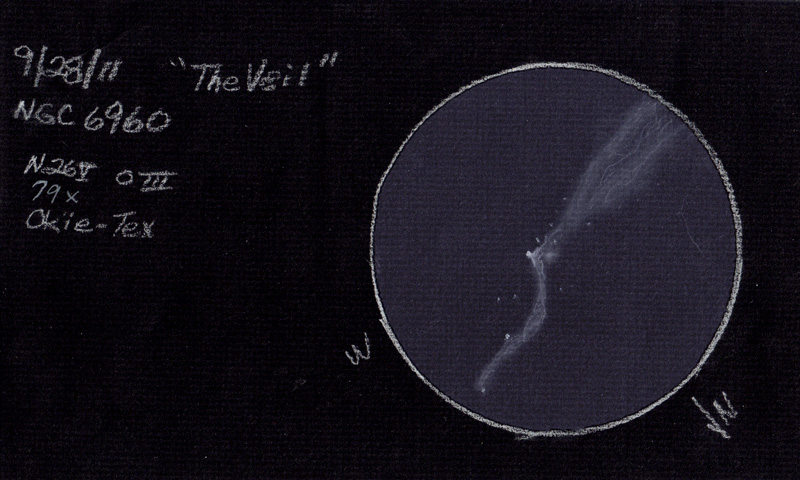
Object Name: The Western Veil – NGC6960 & 52 Cygni
Object Type: Emission Nebula and foreground star
Location: Kenton, OK (Okie-Tex Star Party 2011)
Date: September 28, 2011
Time: 0200 CDT
Media: Conte crayon and white pencil on black paper.
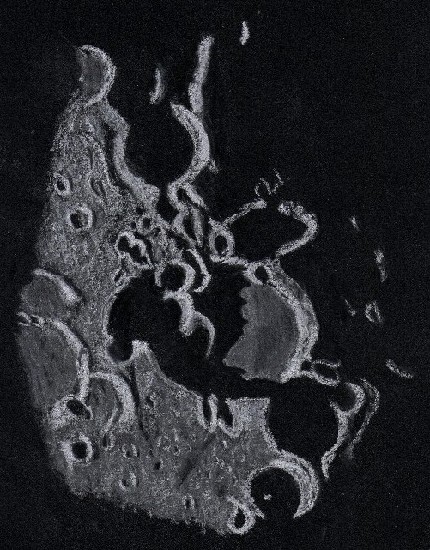
One could sketch the plethora of craters in the southern highlands and not finish them for many years. The craters for sketching chosen here are ones I have not sketched before but were standouts on this evening. The finest sketch I have ever seen of this region was made back in January of 2007 by Sally Russell and can be seen at Astronomy Sketch of the Day for March 27, 2007.
The central large crater that anchors this sketch is Pre-Nectarian period Stöfler a 129 kilometer walled plain with a buried central peak. Piled on top of it to the southeast are a sequence of craters decreasing in size and including one without a name, then Faraday ( 71 km.), Stöfler P ( 34 km.) and Faraday C ( 30 km.). North of Stöfler most of the rim of crater Fernelius (66 km.) was visible but all of the floor was in darkness.
I was forced to work quickly as clouds were rolling in at about the time I was just beyond mid-sketch.
Equipment and Sketching:
Telescope: 10 inch f/ 5.7 Dobsonian on a drive platform 4mm ortho eyepiece 361x
For this sketch I used: black Strathmore 400 Artagain paper 9″x 12″, white and black Conte’ pastel pencils and blending stumps, white Pearl eraser.
Date: 11-2 to 11-3-2011 23:30-00:40 UT
Temperature: 17° C (63° F)
Partly cloudy soon becoming mostly cloudy, high humidity 70%
Waxing gibbous phase
Seeing: Antoniadi III
Transparency: 6/10
Colongitude: 356.6 °
Lunation: 7.2 days
Illumination: 53.2 %
Frank McCabe
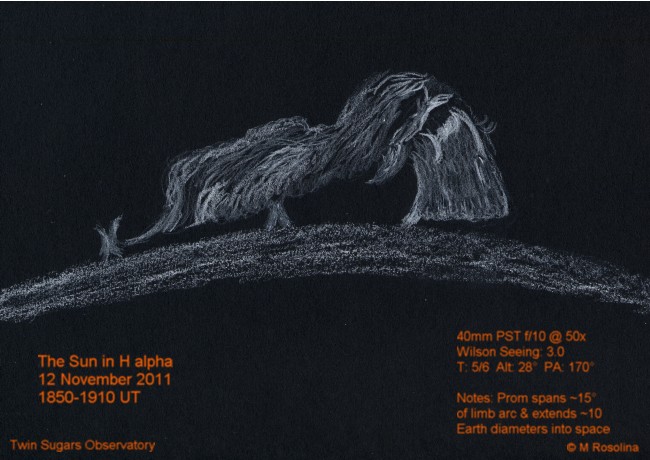
Our star continues to provide stunning sights as we approach solar maximum. This huge prominence, among the biggest I’ve ever seen, is visible in the hydrogen alpha wavelength, but it takes a specially designed scope or filter to see it. My 40mm Personal Solar Telescope (PST) is one such scope.
The prominence consists of superheated solar plasma suspended along magnetic field lines. It is not static, but changes constantly–sometimes the changes happen quickly and sometimes slowly. The appearance of this prominence had changed subtly by the end time of the sketch, so if you want to draw one of these monsters, be prepared to work fast!
The Sun in H alpha
Solar Prominence
Friars Hill, WV USA
12 November 2011 1850-1910 UT
Conte’ crayon, Conte’ pencil, and Derwent Graphtint color pencil on black paper.
Thanks,
Michael Rosolina
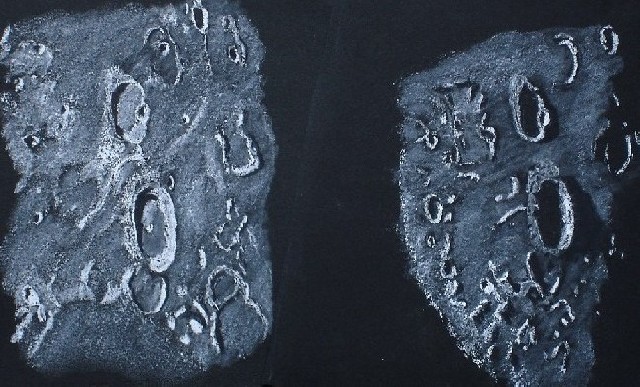
With the Moon at waning gibbous phase, it continues to dominate the night sky for a few more days. On Tuesday night I carefully picked a target area for sketching so that I might catch it again the next night to see the change in shadows a day makes. Lucky for me the sky was clear both nights.
Crater Franklin (58 km.) is the larger and older of the pair and Cepheus (41 km.) has a visible impact crater namely, Cepheus A (13 km.) directly on its northeastern rim.
Sketching Information
First Sketch
Franklin and Cepheus craters on ebony black Canson paper using white and black Conte’ pastel pencils
Sketch Date: August 16, 2011, using a 10 inch f/5.7 Dobsonian telescope riding on an equatorial platform with a 6mm eyepiece for 241x at 05:00-06:10 UT
Seeing: Antoniadi III
Weather: Clear, calm, 59 degrees F (15 degrees C)
Lunation: 16.5 days
Moon 94.3% illuminated
Colongitude: 115.7°
Second Sketch
Same type of paper
Sketch Date: August 17, 2011, using same telescope and same eyepiece at 04:00-05:15 UT
Seeing: Antoniadi III
Weather clear, calm, 64 degrees F (17 degrees C)
Lunation 17.4 days
Moon 89.3% illuminated
Colongitude 127.3°
Frank McCabe

Among the large craters of the lunar southern highlands, a nearly 4 billion year old impact stood out on this evening just after local sunset. This crater is 231 km.diameter Clavius. Clavius is blanketed with a sizable number of craters and numerous craterlets. At the center of this large crater are the reduced remains of the once regal central peaks. The atmosphere was not steady enough to pick out cratelets less than 3 km. never the less, the view was pleasing. Crater Clavius is famous for its semicircular crater sequence of decreasing size beginning with 56 km. Rutherfurd at the inner southeastern wall and continuing with 28 km. D, 21 km. C, 13 km N, 12 km J and 7.5 km JA. The north-northeastern rim of Clavius has a large crater resting upon it and most of its rim is just catching the light of sunrise. This 52 km. diameter crater is Porter. Much of the floor of crater Clavius remains smooth which implies the flow of melted rock in the past. Some geologists speculate it is from some of the ejecta cast outward during the formation of the Orientale basin. Some small secondary crater chains point back in that direction.
Sketching:
For this sketch I used: Canson sketching paper , 9”x12”, white and black Conte’ pastel pencils and blending stumps. Brightness was adjusted after scanning.
Telescope: 10 inch f/ 5.7 Dobsonian and 6 mm eyepiece 241x
Date: 7-10-2011 01:15-03:00 UT
Temperature: 27°C (80°F)
Partly to mostly cloudy, breezy
Seeing: Antoniadi III-IV
Co longitude: 21.4°
Lunation: 8.69 days
Illumination: 70.1 %
Frank McCabe
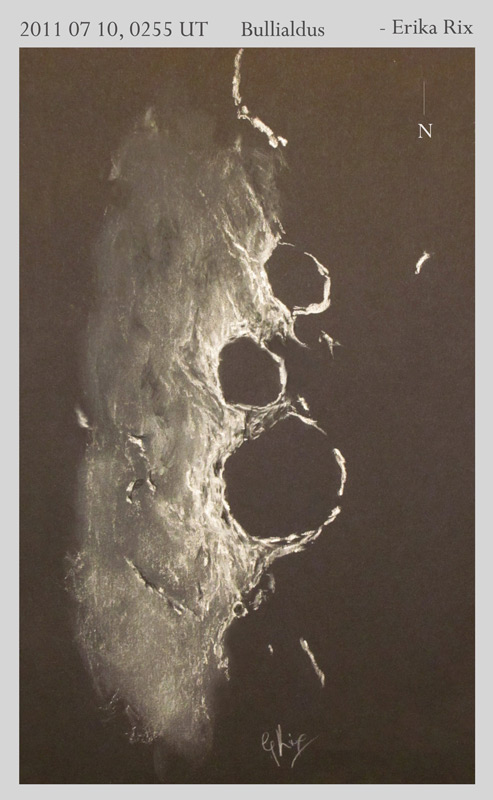
2011 07 10, 0255UT Bullialdus
Erika Rix, Ohio, USA – www.pcwobservatory.com
Bulllialdus: Complex crater from Copernician period (-1.1 billion yrs to present day), Lat: 27.7 deg south, Long: 22.2 deg west.
Zhumell 16”, 21-7mm Zhumell, 257x, no filter
Eyepiece sketch on Strathmore Artagain paper, Conte’ crayon, charcoal
Temp 20C, 92% humidity, S: Antoniadi III, T: 2/6
Phase: 65.5deg, Lunation: 8.75d, Illumination: 70.7%
Lib. Lat: +5deg21’, Lib. Long: +2deg21’
Az: 212deg51’, Alt: 23deg30’
My first thought was to get out my Rite in the Rain paper and charcoal, but that terminator line was looking very dramatic and I decided to try another lunar sketch with black paper and white pastels. I chose the white on black because it can be a lot quicker to draw highlights than to draw shadows and I knew there would be a race against time to sketch on the terminator line. Thanks to my friend, Rich Handy, for introducing me to this media. I’ve found it invaluable for my h-alpha solar work.
Something didn’t really look right to me during my observation. It was only when I called it a night and came back in the house that I realized that Bullialdus A looked a lot larger (and Bullialdus B for that matter) than normal. There’s not a real sharp northern edge to Bullialdus A. It almost has a plateau-like bridge connecting it to the crater Bullialdus. The lighting played against that (or that explanation seems reasonable to me) to make it appear larger than normal.
2011 06 30, 1435 UT
Solar h-alpha, SW prominence
PCW Memorial Observatory, Ohio USA – Erika Rix (www.pcwobservatory.com)
Temp: 24.2°C, Humidity 62%, cirrus
S: Wilson 4.5, T: 1/6-3/6, Alt: 38.3 deg, Az: 090.4 deg
DS 60mm Maxscope, LXD75, 21-7mm Zhumell, 57.14x
Sketches created scope-side with black Strathmore Artagain paper, white Conte’ crayon and pencil, Derwent charcoal pencil, black oil pencil
At first glance, this SW prominence only showed a clear view of its northern leading edge and part of its upper arch. To the south, there was a very bright, segmented area of prominence. Transparency was very poor, but on moments of clearing up, I was able to bump up the magnification to show the very light detailed structure of plasma holding it all together. Then yet further to the south, a tall slender area of prominence forked at the tip and its filament reached into the solar disk in three areas, with the northern one being the longest. Again, I could see faint structures of prominence reaching southward from the segmented prominence.
Object Name : M51, SN2011DH
Object Type : Face-on Galaxy, Supernova
Location : South Korea
Date : June 5th, 2011
Telescope : 15inch Discovery Dobsonian
Media : Black paper, White conte, White pastel
Nightwid (Cho Kang Uk)
Hi all, Supernova SN2011DH was easy to observing.
And I saw beautiful arms and bridge.. Because seeing is very good!
2011 06 01, 1500 UT – 1630 UT
Solar h-alpha, prominences
PCW Memorial Observatory, Ohio USA – Erika Rix, www.pcwobservatory.com
Temp: 32.3°C, Humidity 42%, SE winds 5mph
Seeing: Wilson 4, Transparency: 2/6
DS 60mm Maxscope, LXD75, 21-7mm Zhumell
Sketch created scopeside with black Strathmore Artagain paper, white Conte’ crayon and pencil, Derwent charcoal pencil, black oil pencil
There were six active regions on the Sun, but a western prominence region caught my eye as a possible CME that took place during my observation. If it was simply an erupting prominence, it was the brightest I’ve witnessed as such. I’ve created an animation of my sketch sequence that I recorded during the observation at 5-minute intervals.